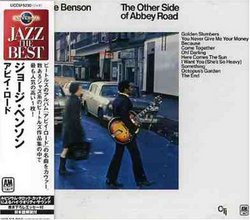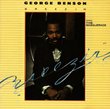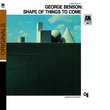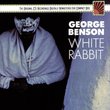| All Artists: George Benson Title: Other Side of Abbey Road Members Wishing: 2 Total Copies: 0 Label: Universal Japan Release Date: 7/12/2004 Album Type: Import Genres: Jazz, Pop Style: Smooth Jazz Number of Discs: 1 SwapaCD Credits: 1 |
Search - George Benson :: Other Side of Abbey Road
 | George Benson Other Side of Abbey Road Genres: Jazz, Pop
Japanese reissue of the guitarist's 1969 pop/jazz translation of the Beatles' swan song 'Abbey Road'. Five tracks (with incorporated medley's). A&M. 2004. |
Larger Image |
CD DetailsSynopsis
Album Description Japanese reissue of the guitarist's 1969 pop/jazz translation of the Beatles' swan song 'Abbey Road'. Five tracks (with incorporated medley's). A&M. 2004. Similar CDs
|
CD ReviewsFor a Cover Album, this is very good L.A. Scene | Indian Trail, NC USA | 05/13/2006 (4 out of 5 stars) "While most people consider "Sgt Pepper's Lonely Hearts Club Band" not only the greatest Beatles album of all time, but the greatest album of all time - I tend to think that "Abbey Road" is the superior album. One reason why I think "Abbey Road" stands out is the state of the Beatles as a band during the time of recording. "Abbey Road" was recorded at a time when tensions and emotions were high between the four members of the band. It is when emotions are high that often a band produces their best work. Fleetwood Mac also did their best work under similar circumstances. Tensions and emotions between the members of Fleetwood Mac were running high when they recorded "Rumours" - and it became their most successful album. Great works are often targets to be covered by other artists. "Rumours" was an album that was covered by a variety of artists on a tribute album: "Legacy: A Tribute to Fleetwood Mac's Rumours". While there was an admirable job of the covers on this collection, it failed to capture the emotions of the original. When I discovered George Benson's "The Other Side of Abbey Road", my initial fears that surrounded the Fleetwood Mac "Legacy" cover began to surface. My curiosity of seeing a legendary Jazz artist such as Benson cover my favorite album outweighed the fears I was having. While I knew it was going to be impossible for Benson to reach the level of emotion that the Beatles had on "Abbey Road", I was very surprised how close Benson came to hitting the mark, I was surprised how much Benson "got it" when it came to covering "Abbey Road".
George Benson is basically a jazz guitarist and vocalist. In the 1970s Benson suddenly found success as a pop star with such hits as "On Broadway", "Give Me the Night", and "Turn Your Love Around". It was Benson's "This Masquerade" that gave him critical acclaim as he would take the coveted award at the 1977 Grammy Awards for Record of the Year. Many people forget that Benson's musical roots are in jazz. It is a jazz cover of "Abbey Road" that is done on "The Other Side of Abbey Road". It is important to note that "The Other Side of Abbey Road" is not a full cover of the Beatles' "Abbey Road". There are only 10 songs that are included on "The Other Side of Abbey Road". The songs that are missing are "Maxwell's Silver Hammer", "Sun King", "Mean Mr. Mustard", "Polythene Pam", "She Came in Through the Bathroom Window", "Carry That Weight", and "Her Majesty". This was something that I found disappointing because I have an immediate curiosity about how Benson would have covered these songs. Benson does not order the remaining songs in the order in which they appear on the original Beatles' "Abbey Road" album. Normally this would be something that disappoints me, however Benson structures the 10 songs included into 5 tracks. Four of the five tracks include combining two or more songs on one track. The five tracks are "Golden Slumbers/You Never Give Me Your Money", "Because/Come Together", "Oh! Darling" (the only 'single' track), "Here Comes The Sun/I Want You (She's So Heavy)", and "Something/Octopus' Garden/The End" (the one track with more than 2 songs). While I didn't feel I would like the way that Benson combined the songs - it works. Benson does a beautiful job at providing the fusion needed on each of these tracks. Benson could have easily found a way to fuse all ten tracks together into a single one - but I do think the way he combined the songs helps to break things up a bit. Benson also doesn't sing all of the tracks. He uses instrumentals for some of the covers while providing partial vocals on others - and this also hits the mark beautifully. Benson also assembles a terrific orchestra to cover the songs. This includes Strings, Woodwinds, Brass, Percussion, and Piano! Included in this band is Herbie Hancock on piano. Here is a brief summary of the five tracks: "Golden Slumbers/You Never Give Me Your Money": Benson "wraps" at the beginning and end a vocalized "Golden Slumbers" around an instrumental "You Don't Give Me Your Money". "Golden Slumbers" has an orchestral feel to it while "You Don't Give Me Your Money" a smooth jazz feel to it (that also has some orchestral qualities to it). "Because/Come Together": This is one of the album's highlights. "Because" starts out with the orchestral feel to it before the segue into "Come Together". Many say Aerosmith nailed the passion of this song with their cover. I would also subscribe that Benson nails it here with his jazzy cover. I love how Benson will improvise later in the song and make the use of the horns. "Oh! Darling": Benson provides a supper-club style feel to this cover. This isn't my favorite Beatles song, but Benson does a nice job on this. "Here Comes the Sun/I Want You (She's So Heavy)": Once again Benson starts out with an orchestral feel ("Here Comes the Sun") and then goes into a jazzy feel of "I Want You". While it doesn't have the same haunting feel of the Beatles original, Benson puts his own haunting spin on "I Want You" (as heard in the instrumentals). "Something/Octopus's Garden/The End": Benson does an incredible job on this. He starts out with an orchestral feel on "Something" that is mostly instrumental with partial vocals. Benson really captures the passion of "Something". The segue isn't quite smooth into "Octopus's Garden" and "The End", but it works. The latter two songs are instrumental and provide a jazzy feel. These latter songs showcase the talents of the band that Benson assembles. I wish the liner notes provided some insight into why Benson did what he did. Still, all in all this is a surprising good cover. Jazz and Beatles' fans should enjoy this." |

 Track Listings (5) - Disc #1
Track Listings (5) - Disc #1


